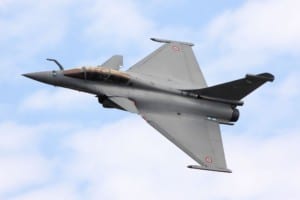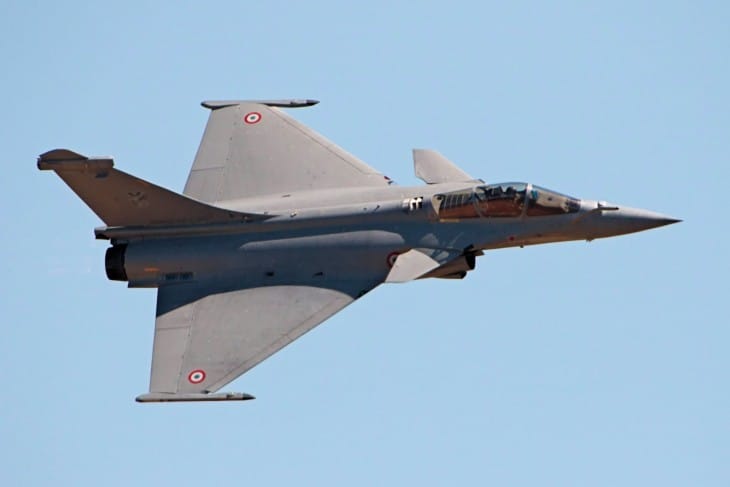The F-22 Raptor and Rafale are both advanced fighter jets that have been used by militaries around the world. They are both capable of performing a wide range of missions and are equipped with some of the most advanced technologies available. So which jet is better?
In this article, we will compare the features and specs of the F-22 and Rafale to see which one comes out on top!
| Aircraft: | Lockheed Martin F-22 Raptor | Dassault Rafale |
|---|---|---|
| Photo: |
 |
 |
| Country: | United States | France |
| Manufactured: | from: 2005 to: 2011 | from: 2000 to: Present |
| ICAO: | F22 | RFAL |
| Price: | $139 million | $120 million |
| Avionics: | Lockheed F/A-22 Integrated avionics, AN/AAR-56 Missile Launch Detector (MLD) | Integrated Modular Avionics, Thales RBE2 AA AESA radar, Thales SPECTRA Electronic Warfare system. |
| Engine: | 2x Pratt & Whitney F119-PW-100 | 2x 2 X SNECMA M88-2 Turbofans |
| Engine Type: | Turbofan | Turbofan |
| Power: | 35,000 pound-force | 17,000 pound-force |
| Max Cruise Speed: |
1963 knots 3,635 Km/h |
1200 knots 2,222 Km/h |
| Approach Speed (Vref): | - | 120 knots |
| Travel Range: |
1,600 Nautical Miles
2,963 Kilometers |
2,000 Nautical Miles
3,704 Kilometers |
| Fuel Economy: |
1.1 nautical mile / gallon 0.538 kilometres / litre |
0.63 nautical mile / gallon 0.308 kilometres / litre |
| Service Ceiling: | 65,000 feet | 55,000 feet |
| Rate of Climb: |
68897 feet / minute 350.00metre / second |
60000 feet / minute 304.80metre / second |
| Take Off Distance: |
480 metre 1,574.78 feet |
400 metre 1,312.32 feet |
| Landing Distance: |
200 metre 656.16 feet |
450 metre 1,476.36 feet |
| Max Take Off Weight: |
38,000 Kg 83,775 lbs |
24,500 Kg 54,013 lbs |
| Max Landing Weight: | - | - |
| Max Payload: |
1,776 Kg 3,915 lbs |
9,520 Kg 20,988 lbs |
| Fuel Tank Capacity: |
2,400 gallon 9,085 litre |
4,370 gallon 16,542 litre |
| Baggage Volume: | - | - |
| Seats - Economy: | 1 seats | 2 seats |
| Seats - Business Class: | - | - |
| Seats - First Class: | - | - |
| Cabin Height: | - | - |
| Cabin Width: | - | - |
| Cabin Length: | - | - |
| Exterior Length: |
18.9 metre 62.01 feet |
15.27 metre 50.10 feet |
| Tail Height: | 5.08 metre - 16.67 feet | 5.34 metre - 17.52 feet |
| Fuselage Diameter: | - | - |
| Wing Span / Rotor Diameter: |
13.56 metre 44.49 feet |
10.9 metre 35.76 feet |
| Wing Tips: | No Winglets | No Winglets |
| More Info: | Lockheed Martin F-22 Raptor | Dassault Rafale |
|
Data presented is for entertainment purposes and should not be used operationally.
|
Other Lockheed Martin F-22 Raptor comparisons:
- Su-27 vs F-22
- F-22 Raptor vs F-14 Tomcat
- F-22 vs Su-35
- F-22 Raptor vs F-15 Eagle
- F-22 Raptor vs MiG 29K Fulcrum
- F-22 Raptor vs Su-57 Felon
- F-22 Raptor vs F/A-18 Hornet
- F-22 Raptor vs F-16 Fighting Falcon
- Lockheed Martin F-22 vs Chengdu J-20
- F-22 Raptor vs F-35 Lightning II
- Eurofighter Typhoon vs F-22 Raptor
- Sukhoi Su-27 vs Lockheed Martin F-22 Raptor
Other Dassault Rafale comparisons:
The F-22 Raptor

The F-22 is a highly advanced multi-role fighter aircraft. It is designed to perform air-to-air and air-to-ground missions. The F-22 has a variety of features that make it one of the most effective fighter jets in the world. For example, the F-22 has stealth capabilities that make it very difficult for enemy radar to detect.
Additionally, the F-22 is equipped with powerful engines that give it supersonic speed and agility. Furthermore, the F-22 is armed with a variety of air-to-air and air-to-ground weapons, making it a very versatile fighter jet.
Finally, the F-22 has state-of-the-art avionics that provides the pilot with exceptional situational awareness.
Why was the F-22 developed and built?
F-22s were designed to be the best air superiority fighters in the world – and they succeeded. F-22s can fly at supersonic speeds without using afterburners, which makes them harder to detect on radar. They also have advanced avionics and sensor suites that give them an unprecedented level of situational awareness.
F-22s can carry a variety of weapons, including air-to-air missiles and precision-guided bombs. In addition, F-22s are equipped with stealth technology that makes them difficult to detect and engage. Even though they are not invisible, F-22s are very difficult to target, making them a deadly force in air-to-air combat.
What purpose does the F-22 serve?
The F-22 is a twin-engine, fifth-generation stealth fighter aircraft that was developed by Lockheed Martin and Boeing. First flown in 1997, the F-22 entered service with the U.S. Air Force in 2005. It is primarily used for air-to-air combat, but can also be configured for air-to-ground attacks.
The F-22 is designed to operate in contested airspace and has many features that make it a formidable opponent. These include stealth technology, advanced avionics, and superior maneuverability.
The Dassault Rafale

The Rafale is a French twin-engine, canard delta wing, multirole fighter aircraft designed and built by Dassault Aviation. Rafale is derived from the French word meaning “gust of wind”, and can refer to several things: a falcon, a type of French pastry, or most famously, an aircraft.
The Rafale has a top speed of Mach 1.8 (1,920 km/h; 1,190 mph) and a range of more than 3,700 km (2,300 mi). It can carry a variety of weapons, including the ASMP-A nuclear missile, and is designed to be able to operate from both an aircraft carrier and a land base.
The Rafale is equipped with an Active Electronically Scanned Array (AESA) radar, infrared search and track (IRST), and an electronic warfare suite. The aircraft is powered by two Snecma M88 engines, which are fed by Two Air Inlet Control Ducts (AICDs). The Rafale has a maximum takeoff weight of 38 metric tons (84,000 lb) and can carry up to 9 metric tons (20,000 lb) of payload.
The Rafale has a wingspan of 10.7 meters (35 ft) and is 13.2 meters (43 ft) long. The Rafale is armed with eight Mica air-to-air missiles in four Dual Mirved Armaments Carrier (DMACs), two on each wingtip.
Why was the Rafale built?
The Rafale aircraft was built and developed for many reasons. Firstly, it is a highly versatile aircraft that can be used for both air-to-air and air-to-ground missions. Secondly, it has a very long range, meaning that it can cover large areas of territory. Thirdly, it is very fast and maneuverable, making it ideal for close combat situations.
Finally, the Rafale is equipped with several state-of-the-art weapons and sensors, making it one of the most advanced fighter jets in the world.
What purpose does Rafale serve?
The Rafale is a twin-engine, multi-role fighter aircraft designed for both air-to-air and air-to-ground missions. It has a max speed of 1,920 km/h and a range of 3,700 km. The Rafale is armed with a 30 mm cannon and can carry nuclear weapons. It can also be equipped with a variety of missiles, including the AASM “Hammer” and the MICA air-to-air missiles.
The Rafale is in service with the French Air Force and the Navy. It has also been sold to Egypt, Qatar, and India. The Rafale is produced by Dassault Aviation.
Differences between the F-22 & Rafale
When it comes to Rafale vs F-22, there are a few key differences to consider. First of all, the Rafale is a 4.5-generation aircraft while the F-22 is a 5th-generation aircraft. This means that the Rafale is slightly less advanced than the F-22. Additionally, the Rafale has a maximum speed of Mach 1.8 while the F-22 has a maximum speed of Mach 2.
The Rafale also has a shorter range than the F-22 – approximately 1,550km compared to the F-22’s 2,000km range.
Finally, the Rafale carries fewer weapons than the F-22 – up to 9 tons compared to the F-22’s 14 tons.
Similarities between the F-22 & Rafale
The Rafale and F-22 are two of the most advanced fighter jets in the world. Rafale is a French aircraft while F-22 is from the United States of America. The Rafale is manufactured by Dassault Aviation and the F-22 by Lockheed Martin. Both these aircraft are technologically very advanced and have several similarities between them.
Both the Rafale and F-22 are equipped with AESA radar, Infrared Search and Track (IRST) system, thrust vectoring engines, and an internal weapons bay. Rafale has more range than F-22 because it is equipped with fuel tanks in its wings. Rafale can carry 9 tons of weapons while F-22 can carry only 6 tons of weapons.
The Dassault Rafale has a better close combat capability than the F-22 because of its Meteor beyond visual range air-to-air missile. The F-22 is stealthier than Rafale because it has a lower radar cross-section.
F-22: What’s Better
F-22 aircraft is faster and has a longer range than the Rafale. The F-22 can fly at Mach 2.5, while the Rafale can only fly at Mach 1.8. F-22 also has a combat range of over 1500 miles, while Rafale’s combat range is only 1200 miles. The F-22 also has better stealth capabilities than Rafale. The F-22 uses stealth technology to make it harder for radar to detect the aircraft, while Rafale does not have this feature.
The F-22 also has better avionics than Rafale. The F-22’s avionics are more advanced and allow for better situational awareness and target tracking. The F-22 also has more powerful engines than Rafale, which provide better performance and fuel efficiency. F-22 engines are also less likely to overheat, providing better reliability in combat situations.
Rafale: What’s Better
Many factors make the Rafale a better aircraft than the F-22. To start, the F-22 was designed for air-to-air combat while the Rafale was designed for both air-to-air and air-to-ground combat. The Rafale also has a better radar system, which allows it to detect and track targets at a longer range. Additionally, the Rafale is equipped with more powerful engines, which give it a higher top speed and better maneuverability. Finally, the Rafale has a larger weapons payload, meaning it can carry more missiles and bombs than the F-22.
Conclusion: F22 vs Rafale
The F-22 and Rafale are both excellent fighter jets with a lot to offer. However, there are some key differences between the two aircraft. The F-22 is faster and has a longer range than the Rafale. Additionally, the F-22 is more stealthy and has better avionics. On the other hand, the Rafale is better equipped for air-to-ground combat and has a larger weapons payload. In the end, it depends on what your needs are as to which aircraft is better.


